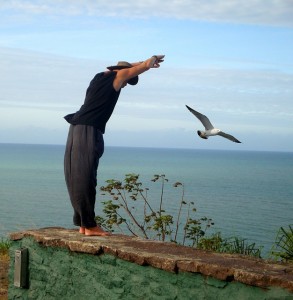My thoughts and a brief introduction on Sensorimotor Therapy for Trauma Clients
In April, I attended a workshop on Trauma and the Body – The Theory and Practice of Sensorimotor Therapy presented by Anne Westcott on behalf of the Sensorimotor Psychotherapy Institute (SPI). I’m particularly interested in theories designed to implement treatment on trauma clients. This particular workshop opened a new realm of possibilities for me. I had my sights on becoming specialized in EMDR in the future but perhaps SPI’s three level certification program is another avenue to explore for me and for anyone seeking to work exclusively with trauma clients. I don’t necessarily believe that one theory is better than another; however, I do believe it is about what works for you the therapist and your clients. The Sensorimotor Psychotherapy Institute was  founded by Pat Ogden in the 1980’s out of her interest in the correlation of client’s disconnections from their bodies/their physical patterns and their psychological issues. Before PTSD appeared in the DSM, Pat recognized that treatments in that time seemed to trigger traumatic reminders in a detrimental way. Sensorimotor Psychotherapy (SP) is drawn from somatic theories, attachment theories, neuroscience, the Hakomi method and cognitive approaches. Pat Ogden quotes “most human behavior is driven by procedual memory – memory for process and function – and is reflected in habitual, automatic responses and well-learned action patterns: movements, postures, gestures, autonomic arousal patterns, and emotional and cognitive tendencies.” This SP workshop explores the processes of memory and how this information can be utilised to change procedural learning in a window of tolerance for the client with PTSD. Specific skills such as tracking and attuning the body are taught. Dysregulation is noted with trauma responses of fight, flight or freeze and how the neuroscience behind the sympathetic and parasympathetic brain structures play a role in these trauma responses. SP uses movement to move the client in a state of active mobilizing defenses into a state of triumph.
founded by Pat Ogden in the 1980’s out of her interest in the correlation of client’s disconnections from their bodies/their physical patterns and their psychological issues. Before PTSD appeared in the DSM, Pat recognized that treatments in that time seemed to trigger traumatic reminders in a detrimental way. Sensorimotor Psychotherapy (SP) is drawn from somatic theories, attachment theories, neuroscience, the Hakomi method and cognitive approaches. Pat Ogden quotes “most human behavior is driven by procedual memory – memory for process and function – and is reflected in habitual, automatic responses and well-learned action patterns: movements, postures, gestures, autonomic arousal patterns, and emotional and cognitive tendencies.” This SP workshop explores the processes of memory and how this information can be utilised to change procedural learning in a window of tolerance for the client with PTSD. Specific skills such as tracking and attuning the body are taught. Dysregulation is noted with trauma responses of fight, flight or freeze and how the neuroscience behind the sympathetic and parasympathetic brain structures play a role in these trauma responses. SP uses movement to move the client in a state of active mobilizing defenses into a state of triumph.
I watched in amazement at some of Pat Ogden’s videos of her demonstrating how to move a client who was suffering into a state of triumph or empowerment. It truly seemed so easy the way she used movement in session; however, I know that it is anything but easy and takes education, great skill and experience. The SPI stresses introducing movement without disrupting the therapeutic alliance by using psychoeducation, client’s willingness, client’s pace, participation of the therapist etc., I can see how many therapists would feel uneasy about using touch in therapy as this therapy relies heavily on touch. I, myself, would not feel comfortable using the same amount of touch that Pat Ogden uses with clients; however, she comes from a yoga instructor background. Many clients may not be open to this type of therapy either. This is why consent would be important and I would encourage a thorough assessment for client readiness and whether this approach is appropriate for your client and their type of trauma.The main component of SP is a mindful one that gets the client to experience elements of their internal experience – ie., their body sensations, movement, emotions, cognition and perceptions and be curious about their experience. This workshop also focuses heavily on dissociation and how to work with clients who dissociate. Just with any theory, there are certain phases in treatment and SP has three distinctive phases for therapists to utilize and be cognizant about. I would recommend anyone who is interested in treating trauma clients to explore SP. There are many YouTube Interviews with Pat Ogden that describe SP in more detail. I would definitely attend another SPI workshop as I was trully amazed at how easily clients improved in their functioning. I’m curious to know if anyone currently uses SP in their treatment modalilities and their stories of effectiveness?
Andrea Cashman is a private practice psychotherapist who has founded Holistic Counselling Services for individual clients seeking therapy in Ottawa, ON. She also practices at the Ottawa Hospital as a registered nurse. Feel free to comment below or contact her at [email protected] or visit her website at www.holisticcounsellingservices.ca
References:
https://www.sensorimotorpsychotherapy.org/about.html
Sensorimotor Psychotherapy Institute 2015 – Trauma and the Body handout
*The views expressed by our authors are personal opinions and do not necessarily reflect the views of the CCPA
The best and most succinct explanation—thank you!